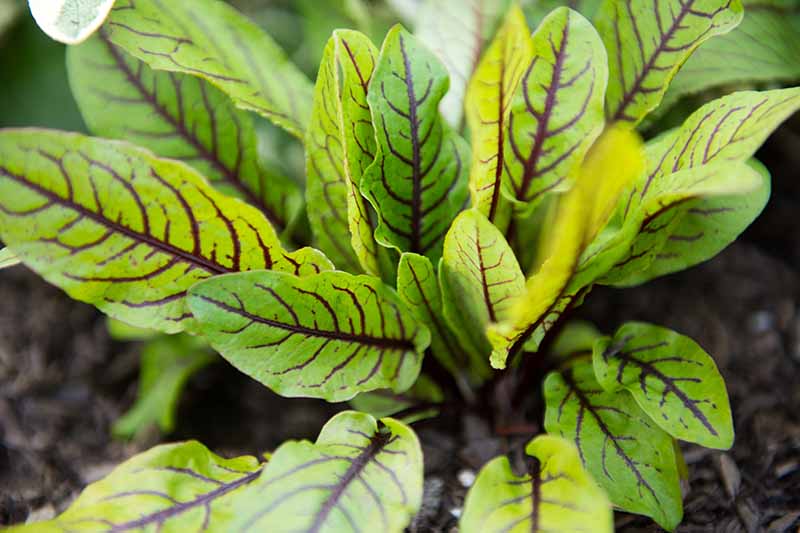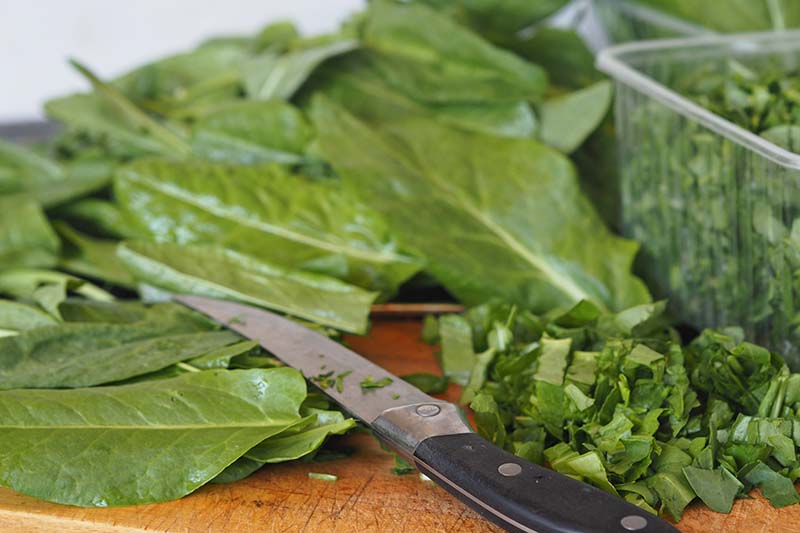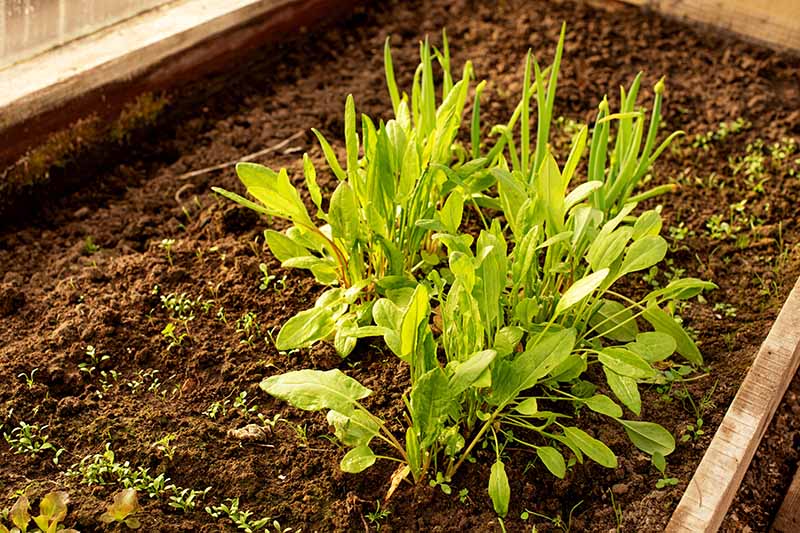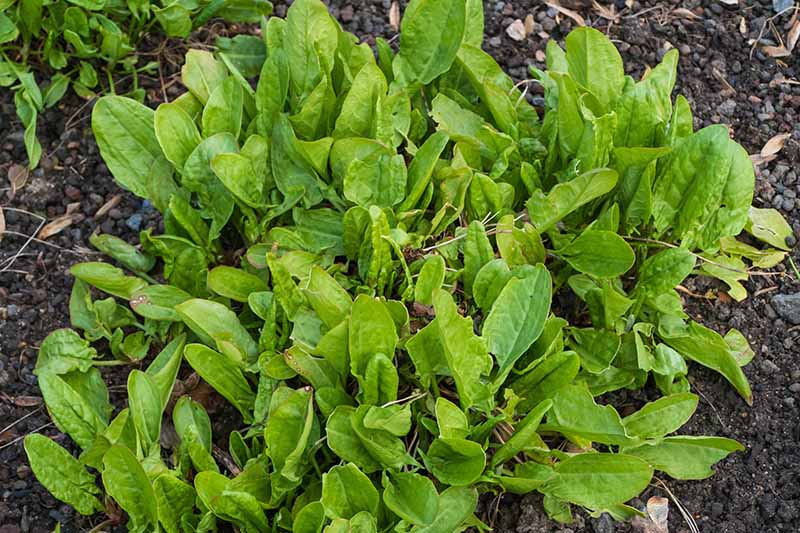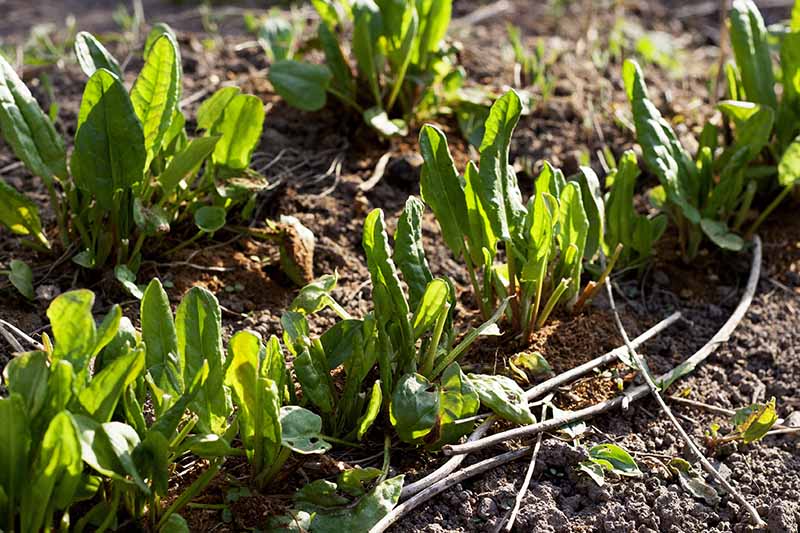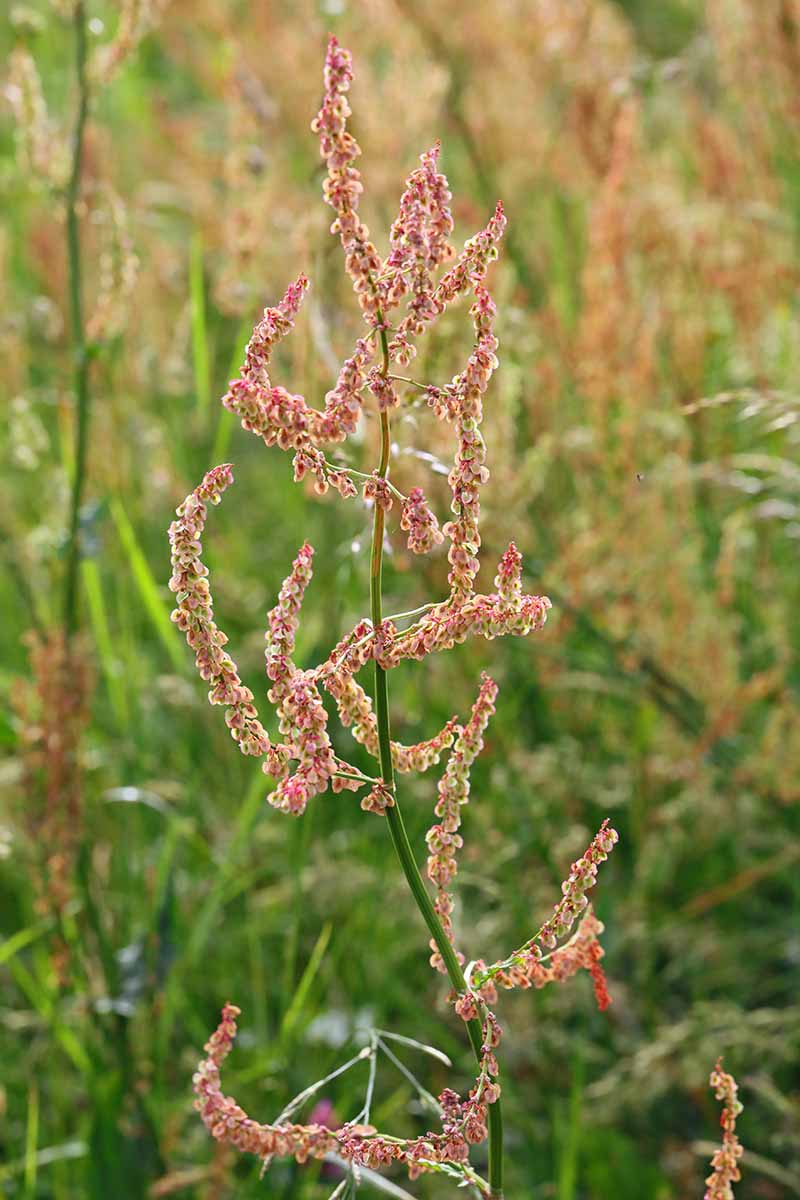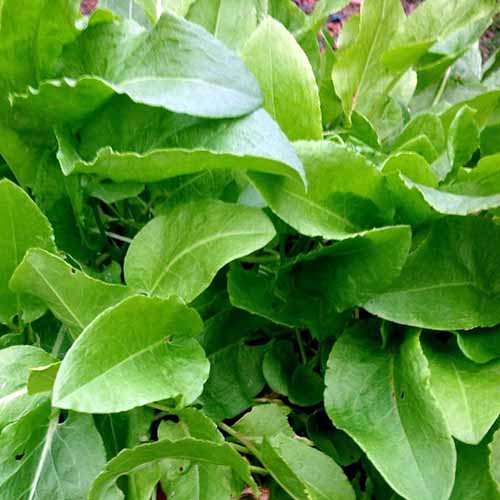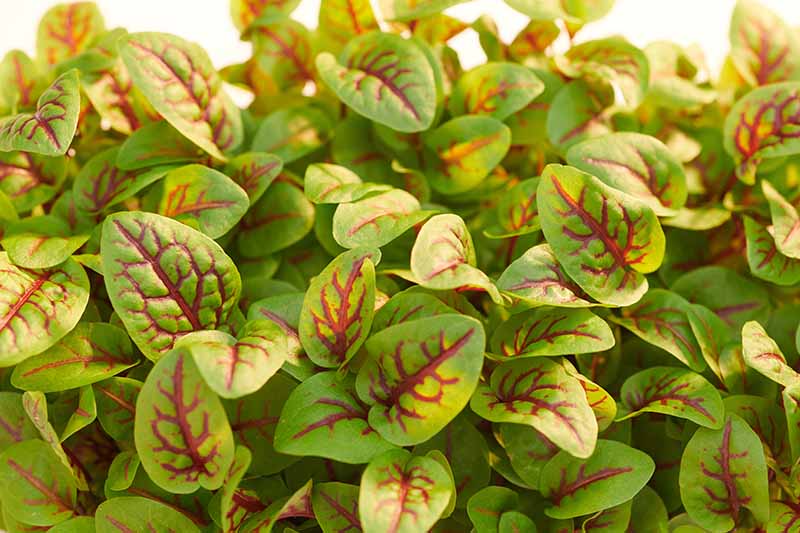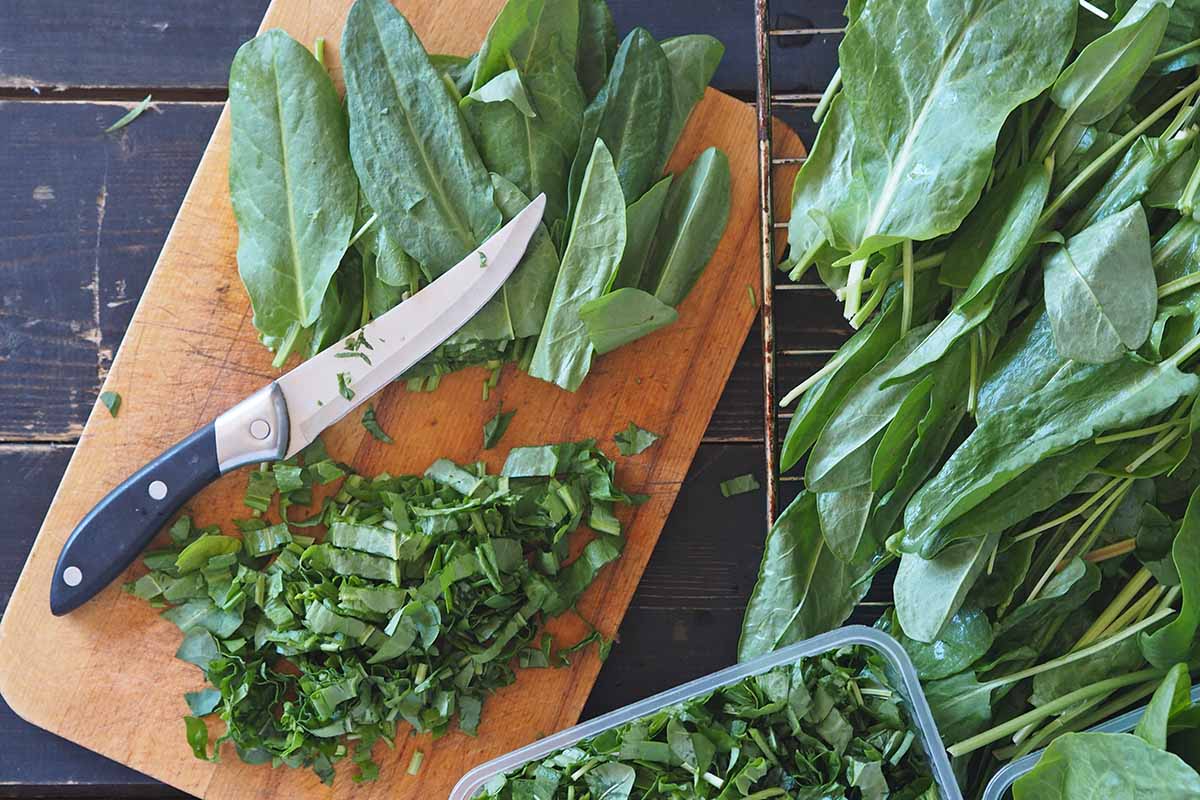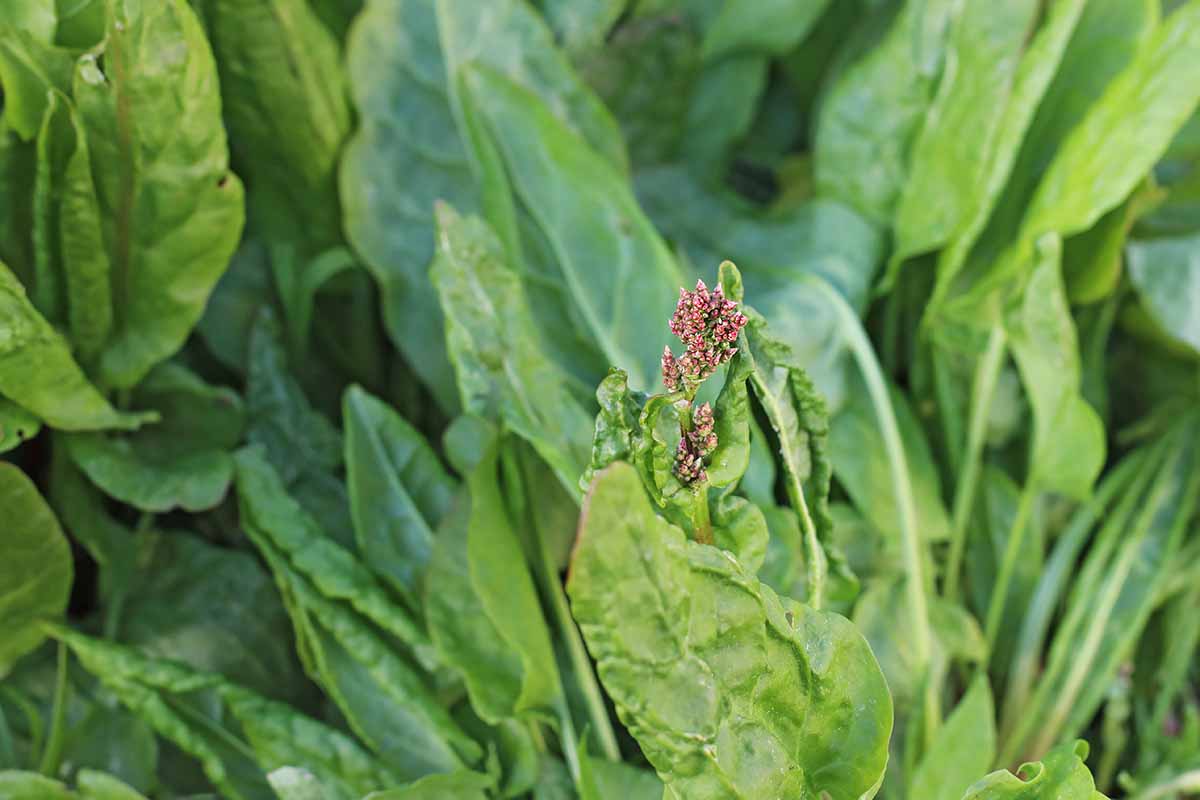This perennial herb or ornamental is adapted to USDA Hardiness Zones 4 to 9. It’s also grown as a leafy green in the vegetable garden, either as an annual or perennial. The seedlings can tolerate frost and part shade, and sorrel will bounce back to produce a second harvest in fall, even if it bolts in summer temperatures. Often it’s the first green to show as winter ebbs in the kitchen garden, and sorrel soup is an annual springtime rite. We link to vendors to help you find relevant products. If you buy from one of our links, we may earn a commission. As much as I love its tendency to reappear in the garden without any prompting from me, even I have to admit that sorrel can be invasive. It readily reseeds, and the mature plants can spread out to occupy a couple of square feet each. Happily, those tendencies are easily overcome by growing sorrel in containers or deadheading the blooms before they reseed. But before we start worrying about an overabundance of this tart plant, let’s cover how to grow and care for it, starting with sowing and wrapping up with picking and cooking. I’ll give you plenty of helpful information along the way. Here’s what we’ll cover:
What Is Sorrel?
Native to Europe and Asia, sorrel is a member of the Polygonaceae, or buckwheat, plant family, it has a dual identity as an herbaceous herb and a baby-leaf green for salads and cooking. The leaves have a lemony flavor that comes from the oxalic acid they produce.They taste best and are most tender picked as baby leaves a couple of inches long. You can eat the leaves if they’re left to grow longer than that, but they’re tougher and the taste begins to be more bitter than tart. In general, it’s a good idea to add this citrusy edible to dishes that also contain milder-tasting greens, or starchy soup ingredients like potatoes or rice. Too much sorrel in a recipe can overwhelm the other flavors. There are three types to consider: Garden or English sorrel, R. acetosa, has lemon-lime colored leaves. It’s the species that’s so popular with Eastern European cooks, who employ it in sour-cream based soups and stews. It grows 18 to 24 inches tall, but the leaves are edible only until they’re about eight inches long. It’s the most acidic variety of this herb. French sorrel, R. scutatus, is distinguished by its fiddle-shaped leaves. It has the lowest oxalic acid content among the species described here, and doesn’t get as big as the others, topping out at six to 12 inches. Red-veined sorrel, R. sanguineus, also known as bloody dock, has red-lined leaves and scarlet stems, and is the most beautiful, if you ask me. Its appearance will remind you that this herb is related to rhubarb, and the plant can grow a couple feet tall and spread a foot or more. While it’s the most attractive for edible landscaping, especially since it will bring a rich red color to part-shade areas of the garden, bloody dock’s culinary uses are more limited than that of the other types. The leaves can only be eaten when they’re four inches in length or smaller; any larger, and they’re way too tough. There’s usually no need to eat overgrown sorrel, though, not when it’s so simple to propagate from transplants, seeds, cuttings, or divisions. Don’t confuse this herbaceous plant with Hibiscus sabdariffa, which also goes by the name sorrel. That tropical plant has its origins in West Africa, is grown around the world, and produces flowers that are used in making a traditional Caribbean beverage. But it grows quite differently than the herbaceous, leafy green variety of sorrel, and we won’t cover that species here. A few techniques will make short work of starting sorrel in your own herb or vegetable garden. Let’s start with propagation.
Propagation
In growing seasons to come, once you’re enjoying a garden full of spreading sorrel that readily reseeds, you may find it hard to imagine that you once had to plant this herbaceous perennial instead of having it come back on its own. To start, or if you plan to grow the baby leaves as an annual vegetable, follow one of these methods:
From Seed
Sow seeds in mid-spring, spacing them an inch apart and a quarter of an inch deep. If you want to harvest bunching greens, plant seeds in rows 12 to 18 inches apart. Then thin the seedlings to eight inches apart once they’re about an inch tall and have at least one set of true leaves. If you intend to eat the entire crop as baby greens, plant 12 seeds per foot. Plan to cut the whole plants when they’re somewhere between three and six inches tall. For plants you intend to grow on as perennials, thin the seedlings to stand 12 to 18 inches apart when they’re a couple of inches tall. The thinnings make a nice addition to the salad bowl. Water in the seeds that you’ve sown and keep the soil moist until they sprout, which usually takes about two weeks. You can also start seeds indoors about three weeks before the average last frost in your area, making sure they receive bright light and stay moist until sprouting.
From Transplants
Wait a week or so after the average last frost date in your area before transplanting sorrel. The seedlings will succumb to hard frost or below-freezing temperatures. Work the soil to about eight inches down, and add plenty of aged organic matter. Place the plants where they’ll stand at least 12 inches apart from each other and other herbs, vegetables, or garden elements like walls or statuary. Set each seedling to a depth where the crown is even with, not below, the soil line. If you bury the crown beneath the soil, moisture may pool in the crown and rot the plant. Backfill and water the seedlings in.
From Divisions
Mature sorrel will clump and spread to a foot or more. If you have a source who’s willing to share, you can divide theirs to start a new crop in your garden. The best time for dividing is early spring, so the transplants will have plenty of time to adjust before warm weather sets in. If you divide during other times of the growing season, just make sure to shade or cover the transplants to protect them from weather extremes, as needed. Or pot them up and bring them into the house for a period of adjustment before transplanting when the weather’s cooler. Splitting the mature plants is fairly straightforward: Insert a sharp shovel about 10 inches below the crown of the plant and lift the whole clump up, bringing up as many roots as possible. Then use a trowel or your hands to separate the individual seedlings within the clump. Or, use a mattock or sharp shovel to chop the clump of soil into sections, each with its own roots, stalks, and leaves attached. Learn more about dividing perennials in our guide.
How to Grow
Sorrel prefers well-draining soil with plenty of rich organic matter worked in. Its ideal pH is from 5.5 to 6.8. It grows best in full sun, about six hours per day, but it can also tolerate light shade. A partial shade location is the best option if you’d like to slow the plants from bolting and improve the quality of the leaves during the hottest weather, but the leaves won’t grow as quickly for the rest of the season. Or you can opt for containers and place the pots in full sun most of the year, and in light shade for the summer months. If you’re going the container route, choose one with a drainage hole, or one that you can puncture to create a hole for drainage. The pot should also be at least six inches wide for a single plant, and made of a material that retains moisture. Avoid clay pots that haven’t been sealed, since this leafy green needs moisture and they’ll dry out quickly. For larger containers that will hold several plants, opt for lightweight materials or they’ll be too heavy to move for water, shade, or freeze protection. If you might need to shift them often during the growing season, also consider a rolling plant stand. To grow the healthiest sorrel with juicy stems and flavorful leaves, you’ll want to keep the soil moist but not soggy. To help retain moisture, mulch around the plants with a couple inches of grass clippings, pine straw, or shredded bark. Do this once you’ve thinned the plants to their final spacing, though you can skip this step if you plan to harvest yours only as baby greens. Also, make sure the mulch material hasn’t been treated with herbicides that would leach into the soil, or pesticides that would harm vegetable garden pollinators. Throughout the growing season, the plants need about an inch of water per week, so supplement as needed if the rain doesn’t provide enough. When you water, make sure to direct the stream towards the soil line, and don’t splash. Overhead watering may get the leaves too wet, and can also transport fungal diseases from plant to plant.
Growing Tips
Grow sorrel in moist, fertile soil.Plant seedlings with their crowns above the soil to discourage rotting.Mulch to retain moisture and suppress weeds.Provide an inch of water per week throughout the growing season in the absence of rain.
Pruning and Maintenance
Unlike a lot of herbs and vegetables, sorrel needs only a little encouragement to thrive throughout the growing season. If you planted yours in suitably fertile soil with plenty of humus, for example, they don’t require additional fertilizer. If they seem lackluster, you may want to add a general-purpose fertilizer as a side dressing leading into fall, when they’ll produce a new round of leaves, even if they bolted in summer. You will want to attack any weeds early, hoeing them out or pulling them before they grow to a large size and take over. Just be careful not to hack or uproot sorrel seedlings in the process. You should cut the seed stalks as soon as you see them in the warm months, unless you specifically are trying to save seeds. That won’t make the long leaves that have already grown any more tender or less bitter, but it will encourage the plants to send up a new set of baby leaves. If you notice the whole plant has produced too-long leaves that are tough and inedible, consider chopping them all off an inch or two above the crown. Do this sometime after summer’s heat has abated, and a month or more ahead of the average first frost in your area. It should regrow fresh, tart, tender leaves in no time flat. One other bit of maintenance is crucial when you’re growing these herbs for continuous harvest as perennials. When the plants are two or three years old, they’ll start to brown and weaken. Prevent or cure this by trimming off all the withered or lackluster leaves and dividing the tired plants using the instructions in this guide’s “Propagation” section above. Not only will the plants revive readily, you’ll have a new plant or two to share with fellow gardeners or to plant elsewhere.
Managing Pests and Disease
When you see sorrel growing in the lawn and thriving wherever its seeds touch soil, it practically screams, “I don’t have pest problems!” To grow your own from seed, here are three sources:
French
This milder, smaller French heirloom is tasty as a salad green, or cooked into a creamy, buttery soup. It grows just six to 12 inches high, and the baby leaves are ready to pick 40 to 60 days from sowing. French Sorrel
Garden
This type has spritely, springtime-green leaves. It’s high in oxalic acid, which is why many chefs cut the tart effect by adding sour cream to soups made with this variety. It reaches the baby-leaf stage in 45 days, and can be harvested at its full size about three weeks after that. Garden Sorrel Seeds are available in various package sizes from True Leaf Market.
Red Veined
This beautiful sorrel, with bright green leaves and red veins and stems, is prized for its edible baby leaves and also as an ornamental plant. Red Veined Sorrel It takes 40 to 60 days to mature from sowing. Red-veined sorrel seeds are available in various packet sizes and in bulk from True Leaf Market. And it really doesn’t. While you may occasionally see aphids on the plants, you can usually do away with them just by using a strong spray of water from the hose. To prevent them from targeting your plants, make sure they get ample air circulation by spacing them a proper distance apart, so the aphids aren’t given free protection from the elements as they nosh on the plants. And consider planting sorrel next to the leafy herbs that attract beneficial insects that like to devour aphids, including members of the mint family. Learn more about aphid control in our guide. Snails and slugs may also munch on these plants. Infestations can be prevented with diatomaceous earth, or treated with beneficial nematodes. As for disease, no problems there – I mean, almost no problems. Sometimes sorrel will develop crown rot, but that’s handily avoided when you refrain from planting the crowns beneath the soil, where they can get too wet. To learn more about identifying and treating crown rot, see our guide.
Harvesting and Storage
You can harvest the greens or herbs throughout the time when they’re actively growing, meaning spring through summer and again in early fall. Once the plants have bolted in warm weather, the leaves will get too tough to eat. But don’t despair if you let the leaves get too long to pick. These plants will produce a new round of tender shoots again in fall. Just don’t try to pick fresh garden-grown greens after the plants have died down in winter. Those leaves are bitter and the texture is limp. Baby-leaf sorrel is ready to pick 30 to 40 days after sowing. Pick individual leaves, starting on the outside and leaving those nearer to the crown to keep growing. Or, if you’re growing the plants for baby leaves alone, sever the whole plant at the crown when it’s three to six inches tall. You can then turn the roots under the soil, or pull them up and compost them. One of the great joys of growing this particular plant is that it produces fresh herbs or greens for the kitchen over the course of almost six months. To get full enjoyment from your gardening efforts, I recommend picking sorrel hours – if not minutes – before you’re ready to eat it in a salad or cook with it. If that’s not possible, you can store the unwashed leaves you harvested in a plastic bag in the crisper drawer in the fridge. Just be sure to take them out and wash them to use within three days.
Preserving
I am always going to encourage gardeners who are avid home cooks to grow successive plantings of sorrel for greens or use as a fresh herb, rather than trying to “put up” bunches of the mature leaves in the freezer. I reason that it tastes so wonderful when it’s fresh, tender, and tart, and is available that way for most of the year, so to me it’s not worth the effort to consume less-than-perfect leaves. The second-best option in my opinion is to grow microgreens of this lemon-flavored plant when the fresh eating isn’t available. You can find instructions for growing microgreens in our guide. But if successive plantings don’t appeal to you, or you don’t have the space, it is possible to dry sorrel leaves the same way you would other leafy herbs. You’ll want the freshest, two- or three-inch leaves for this. Wash and dry them, then spread the leaves out on a baking sheet lined with parchment paper. Dry them in an oven set to the lowest heat, no higher than 200°F. Keep an eye on them so they don’t scorch, and take them out when they’re dry and crunchy, which usually takes about 15 minutes. Once they’re cool, use your fingers to crumble them into flakes and store them in an airtight container to use as you would dried parsley. Find more tips on drying herbs here. You can also make an herb compound butter and freeze it in small portions in plastic containers. To do that, take the stems from a couple of small or midsize leaves and mince them fine. Mash a half-cup of softened butter, and then add a teaspoon of lemon juice, a clove of minced garlic, and salt and pepper to taste. Stir in the herb. Store a couple of tablespoons in each container, and defrost in the fridge or on the counter before using.The mixture is tasty spread on grilled bread or tossed with piping hot pasta. My one exception to the “don’t bother to freeze it” rule is French sorrel, but only if you’re a big fan of the soup. You can take these milder, less acidic leaves, wash them, let them dry completely, chop them roughly, and then freeze them in a single layer in a flat freezer bag. They go from there straight into the soup pot, perhaps using the recipe that is coming right up.
Recipes and Cooking Ideas
In its herbal role, the uses for sorrel are unlimited. A small amount washed, dried, and minced makes a lively accent for recipes including sour cream dip, creamy sauces, scrambled eggs, Italian wedding soup, and tacos, and the list goes on and on. You can use the tangy leaves in place of about one-third of the kale in this recipe for turmeric red lentil soup with kale from our sister site, Foodal. It also zips up the recipe as an alternative for maybe a cup of the escarole in this Italian wedding soup recipe, also from Foodal. But add it in the last five minutes of simmering, particularly if you’re using smaller leaves, which tend to disintegrate. To get a bit fancier, consider using a teaspoon of minced sorrel leaves in addition to the thyme in this nutty condiment. You’ll find the recipe for fresh thyme pine nut butter on Foodal. A handful of the leaves picked while they’re still a dainty inch or two long also lends a fresh, lemony accent to entree salads like this chicken lunchtime salad with fresh cherry vinaigrette. Or, use a cup of baby-leaf sorrel as part of the six cups of mixed greens called for in our sister site’s recipe for savory spinach pie. Just keep in mind that cooking turns the leaves a yellowish brown, so you’ll either want to combine them with an herb that stays green, like parsley, or add them to smoothies raw so the color is more appealing. Finally, if French sorrel is your thing, you may want to give the signature soup a go. I’d advise trying this either in spring, when the leaves are at their tart, tender best, or in early autumn, when they send up new shoots or if you transplant some new seedlings into the fall garden. The traditional Ukrainian, Polish, or Russian version involves a lot of full-fat sour cream, and I’ve even seen recipes that include mayonnaise! The French version is usually laden with yummy butter and finished with heavy cream. So you can eat it often, particularly as part of a lazy weekend brunch or a time-pressed weekday dinner, I’m going to share a lighter version. This is one to make with the freshest leaves in spring, or maybe a couple handfuls of microgreens grown in the dead of winter. I recommend blending this concoction so it’s creamy, but I’ve also cooked this as a hearty soup with no pureeing. While it’s not as elegant, it still tastes great.
Simple and Light Springtime Sorrel Soup
To make a light and lively version of sorrel soup, you’ll need a cup of chopped spring onions that includes two inches of the green tops, two cloves of minced garlic, a tablespoon of olive oil or non-stick spray, four vegetarian bouillon cubes dissolved in four cups of water, two cups of peeled, diced russet potato, four cups of washed and trimmed baby sorrel leaves, two tablespoons of softened, unsalted butter, and salt and pepper to taste. Begin by preparing the alliums, sauteing the green onion over medium heat in a non-stick soup pot or large saucepan coated with olive oil or spray. Cook it for four minutes, then stir in the garlic and saute for another minute. Add the bouillon to the pot, bring it to a boil, and then stir in the potatoes. Return a boil, reduce the heat to medium, and cook until the potatoes are falling-apart tender, about 20 minutes. While the soup base cooks, roughly chop the sorrel leaves, and then pulse them in a food processor or blender until they’re finely chopped. Gently work the butter into the bowl or blender with the minced leaves, then pulse again until the mixture forms a smooth paste. Season the soup base to taste with salt and pepper, then puree it with an immersion blender. Right before serving, stir the sorrel mix into the soup pot, and then blend again just until smooth. Serve immediately with a dollop of sour cream or a vegan, nut-based alternative. Or, chill in the fridge for up to two days and serve cool or at room temperature. Early spring green? Frozen herb butter ingredient? Small space garden or container option? Edible landscaping element? Sorrel meets all of those demands, and many more besides. If you have experience with or questions about growing this herbaceous perennial, kindly chime in via the comments section below. And if you want to learn more about planting and caring for some other herbaceous perennials, check out these herb growing guides next:
How to Grow and Care for French TarragonTips for Growing Rosemary IndoorsHow to Grow and Use Hyssop

